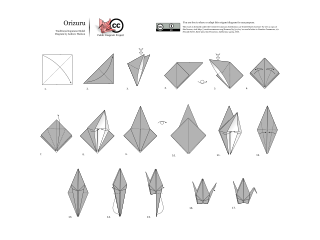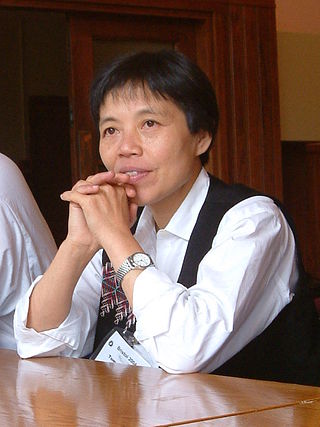Biography
John Montroll was born in Washington, D.C. [1] He is the son of Elliott Waters Montroll, an American scientist and mathematician. He has a Bachelor of Arts degree in Mathematics from the University of Rochester, a Master of Arts in Electrical Engineering from the University of Michigan, and a Master of Arts in applied mathematics from the University of Maryland. [2]
Montroll mastered his first origami book, Isao Honda's How to make Origami, at the age of six, [1] the same age he began creating his own origami animals. [3] He became a member of the Origami Center of America at age twelve. [1] He attended his first origami convention at age 14. In 2021, Montroll retired from his job at St. Anselm's Abbey School in Washington, D.C., where he taught mathematics, as well as an origami class. One of John Montroll's hobbies is whistling. He claims to be able to whistle in five octaves and to have shown this talent at two whistling conventions in Louisburg, North Carolina. [4]
John Montroll pioneered modern origami with the publication of his first book, Origami for the Enthusiast; Dover Publications, 1979, which was the first origami book where each model is folded from single square sheet and no cuts. [5] In the same book he introduced the origami term "double rabbit ear fold." [6] He is also known for inventing the "dog base" [7] . His work in the field of origami was briefly mentioned in the York series by author Laura Ruby.

Origami is the Japanese art of paper folding. In modern usage, the word "origami" is often used as an inclusive term for all folding practices, regardless of their culture of origin. The goal is to transform a flat square sheet of paper into a finished sculpture through folding and sculpting techniques. Modern origami practitioners generally discourage the use of cuts, glue, or markings on the paper. Origami folders often use the Japanese word kirigami to refer to designs which use cuts.

The Yoshizawa–Randlett system is a diagramming system used to describe the folds of origami models. Many origami books begin with a description of basic origami techniques which are used to construct the models. There are also a number of standard bases which are commonly used as a first step in construction. Models are typically classified as requiring low, intermediate or high skill depending on the complexity of the techniques involved in the construction.

Modular origami or unit origami is a two-stage paperfolding technique in which several, or sometimes many, sheets of paper are first folded into individual modules, or units, and then assembled into an integrated flat shape or three-dimensional structure, usually by inserting flaps into pockets created by the folding process. These insertions create tension or friction that holds the model together.
Peter Engel is an American origami artist and theorist, science writer, graphic designer, and architect. He has written several books on Origami, including Origami from Angelfish to Zen, 10-Fold Origami: Fabulous Paperfolds You Can Make in Just 10 Steps!, and Origami Odyssey.

Erik D. Demaine is a professor of computer science at the Massachusetts Institute of Technology and a former child prodigy.

In geometry, the snub disphenoid, Siamese dodecahedron, triangular dodecahedron, trigonal dodecahedron, or dodecadeltahedron is a convex polyhedron with twelve equilateral triangles as its faces. It is not a regular polyhedron because some vertices have four faces and others have five. It is a dodecahedron, one of the eight deltahedra, and is the 84th Johnson solid. It can be thought of as a square antiprism where both squares are replaced with two equilateral triangles.

Robert J. Lang is an American physicist who is also one of the foremost origami artists and theorists in the world. He is known for his complex and elegant designs, most notably of insects and animals. He has studied the mathematics of origami and used computers to study the theories behind origami. He has made great advances in making real-world applications of origami to engineering problems.

Tomoko Fuse is a Japanese origami artist and author of numerous books on the subject of modular origami, and is by many considered as a renowned master in such discipline.

The Sonobe module is one of the many units used to build modular origami. The popularity of Sonobe modular origami models derives from the simplicity of folding the modules, the sturdy and easy assembly, and the flexibility of the system.
Kunihiko Kasahara is a Japanese origami master. He has made more than a hundred origami models, from simple lion masks to complex modular origami, such as a small stellated dodecahedron. He does not specialize in what is known as "super complex origami", but rather he likes making simple, elegant animals, and modular designs such as polyhedra, as well as exploring the mathematics and geometry of origami. A book expressing both approaches is Origami for the Connoisseur, which gathers modern innovations in polyhedral construction, featuring moderately difficult but accessible methods for producing the Platonic solids from single sheets, and much more.

Father Magnus J. Wenninger OSB was an American mathematician who worked on constructing polyhedron models, and wrote the first book on their construction.

Kawasaki's theorem or Kawasaki–Justin theorem is a theorem in the mathematics of paper folding that describes the crease patterns with a single vertex that may be folded to form a flat figure. It states that the pattern is flat-foldable if and only if alternatingly adding and subtracting the angles of consecutive folds around the vertex gives an alternating sum of zero. Crease patterns with more than one vertex do not obey such a simple criterion, and are NP-hard to fold.
Joseph O'Rourke is the Spencer T. and Ann W. Olin Professor of Computer Science at Smith College and the founding chair of the Smith computer science department. His main research interest is computational geometry.

St. Anselm's Abbey School is an all-boys preparatory school for grades six through twelve in Washington D.C., United States. It is located in the Roman Catholic Archdiocese of Washington. The school sits on a 40-acre wooded campus in the Michigan Park neighborhood of the city's Northeast quadrant. It is run by the Benedictine monks of Saint Anselm's Abbey.
The napkin folding problem is a problem in geometry and the mathematics of paper folding that explores whether folding a square or a rectangular napkin can increase its perimeter. The problem is known under several names, including the Margulis napkin problem, suggesting it is due to Grigory Margulis, and the Arnold's rouble problem referring to Vladimir Arnold and the folding of a Russian ruble bank note. Some versions of the problem were solved by Robert J. Lang, Svetlana Krat, Alexey S. Tarasov, and Ivan Yaschenko. One form of the problem remains open.
Origami Polyhedra Design is a book on origami designs for constructing polyhedra. It was written by origami artist and mathematician John Montroll, and published in 2009 by A K Peters.
Rona Gurkewitz is an American mathematician and computer scientist, known for her work on modular origami. She is a professor emerita of computer science at Western Connecticut State University, and the former head of the department of computer science there.
Tomohiro Tachi is a Japanese academic who studies origami from an interdisciplinary perspective, combining approaches from the mathematics of paper folding, structural rigidity, computational geometry, architecture, and materials science. His work was profiled in "The Origami Revolution" (2017), part of the Nova series of US science documentaries. He is a professor at the University of Tokyo.











